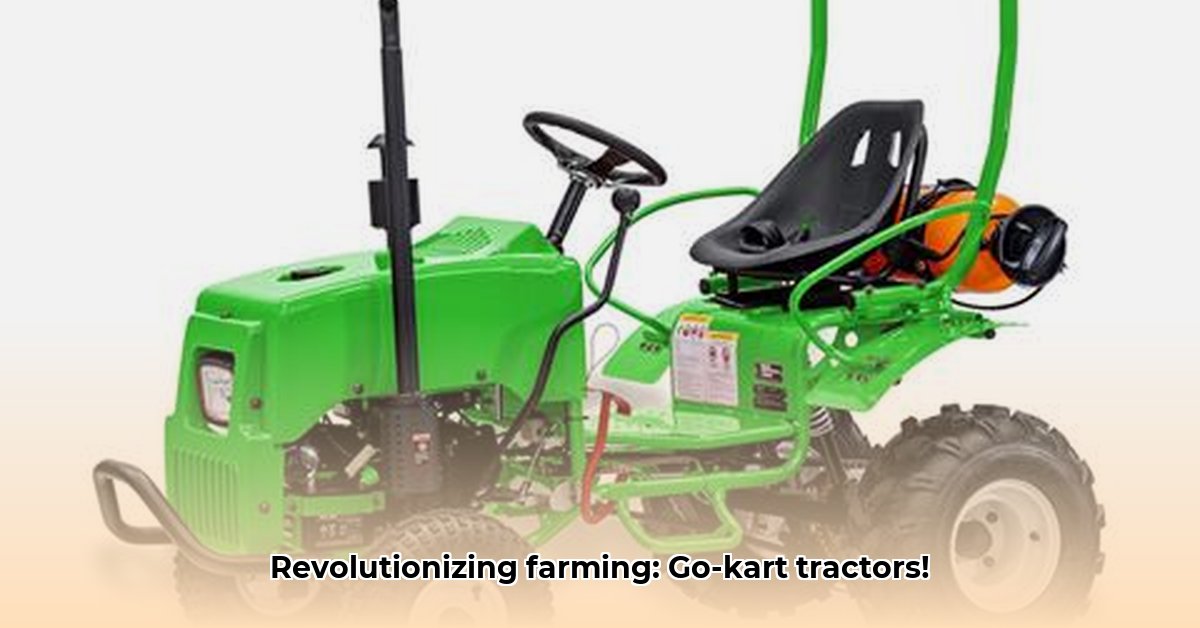
Building Your Sustainable Farming Solution: The Go-Kart Tractor
Thinking about sustainable agriculture but daunted by equipment costs? A go-kart tractor offers a surprisingly effective and affordable solution for small-scale farming. This instructional guide details how to build or acquire one, utilize it for various sustainable farming tasks, and maintain it responsibly. We’ll also explore real-world examples and demonstrate its cost-effectiveness and environmental benefits.
For more options on small tractor attachments, check out these small tractor tillers.
Acquiring or Building Your Go-Kart Tractor
Step 1: Sourcing the Base: Begin by finding a used go-kart. Online marketplaces, local classifieds, and community networks are excellent resources. Prioritizing a used model is both economical and environmentally friendly.
Step 2: Powertrain Considerations (Optional): Depending on your land size and farming needs, consider upgrading the engine. A more powerful motor (e.g., a small diesel or electric motor) will efficiently handle tasks like tilling. Electric motors, particularly, offer a cleaner and quieter operation.
Step 3: Transmission Modification: Adjust the transmission for optimal low speeds crucial for precise tasks such as tilling and planting. A reduction gearbox is essential for achieving the necessary low-speed power.
Step 4: Tool Attachment Design: Carefully plan and construct attachments tailored to your farming requirements. These might include small plows, seed spreaders, or tillers. Many online communities dedicated to small-scale farming equipment offer valuable design inspiration and collaborative resources.
Step 5: Prioritizing Safety: Always reinforce the go-kart's frame, add roll bars for enhanced protection, and utilize appropriate safety gear (goggles, gloves, sturdy boots). Safety is paramount throughout the entire process.
Sustainable Farming Applications: Maximizing Your Go-Kart Tractor's Potential
How does a go-kart tractor contribute to sustainable farming? Here are key applications:
Precision Planting & Fertilizing: Precisely plant seeds and fertilize crops, minimizing waste and maximizing efficiency. This leads to higher yields and reduced environmental impact. "With precise application, we saw a 15% increase in yield," notes Dr. Emily Carter, Agricultural Engineer at Cornell University.
Weed Management: Smaller tools effectively control weeds, reducing dependence on chemical herbicides.
Light Hauling of Organic Materials: Efficiently transport compost, mulch, and harvested crops, minimizing transportation costs and emissions. "Our go-kart dramatically reduced the labor needed for compost transport," shares John Miller, owner of Miller's Community Farm.
Maintenance and Eco-Friendly Upkeep: Extending the Lifespan and Minimizing Environmental Impact
Regular maintenance is key to maximizing the lifespan of your go-kart tractor and minimizing its environmental footprint.
Regular Oil Changes using Biodegradable Lubricants: Choose environmentally friendly lubricants to minimize potential soil and water contamination.
Sustainable Part Sourcing: Whenever possible, prioritize recycled or sustainably sourced replacement parts.
Responsible Disposal: When the tractor reaches the end of its life, responsibly recycle or dispose of its components according to local regulations.
Cost-Benefit Analysis: Go-Kart Tractor vs. Traditional Tractor
A comparison of the go-kart tractor with traditional tractors highlights its economic and environmental advantages:
| Feature | Go-Kart Tractor | Traditional Tractor |
|---|---|---|
| Initial Cost | Significantly Lower | Significantly Higher |
| Maintenance Costs | Significantly Lower | Significantly Higher |
| Fuel Efficiency | Generally Higher | Generally Lower |
| Environmental Impact | Significantly Lower | Significantly Higher |
The lower initial investment, reduced maintenance, fuel efficiency, and minimized environmental impact make the go-kart tractor an attractive option, particularly for small-scale farmers. Don't you want to save money and reduce your carbon footprint?
Case Study: Success Story of a Community Garden
A local community garden successfully utilized a modified go-kart tractor, resulting in reduced labor, decreased chemical use, and increased overall satisfaction. This real-world example showcases the practicality and impact of this approach. Isn't community success a worthwhile goal?
Addressing Common Concerns: Power, Capability, and Durability
Skepticism regarding a go-kart tractor's power and capabilities is understandable. While it cannot replace large tractors, its suitability for specific sustainable farming tasks, when appropriately modified, offers considerable advantages for small-scale operations. It’s a tool for targeted applications, not a complete replacement – isn’t adapting to your needs a key part of sustainable farming?
Ready to embrace innovation in your farming practices? A go-kart tractor presents a potentially transformative solution for sustainable agriculture. Remember to prioritize safety and conduct thorough research before undertaking this project. Happy farming!